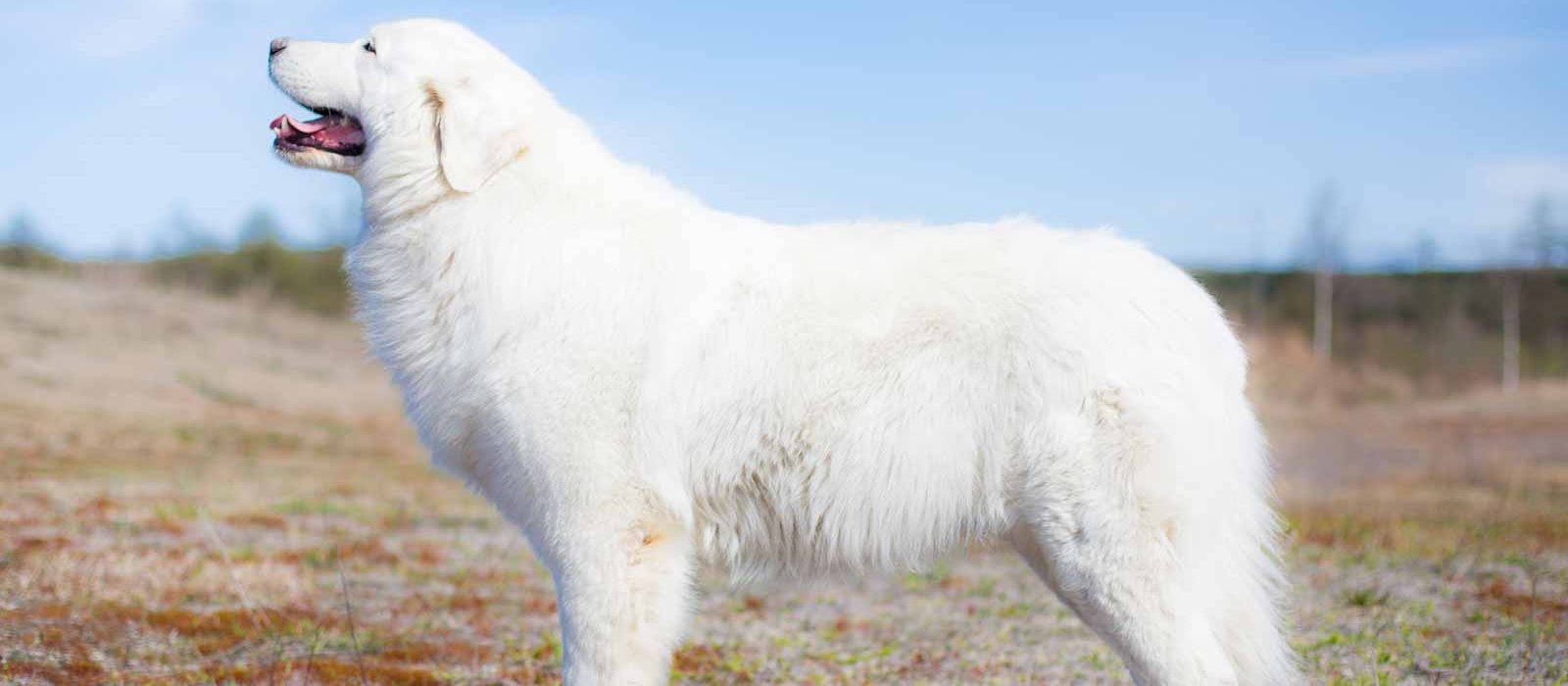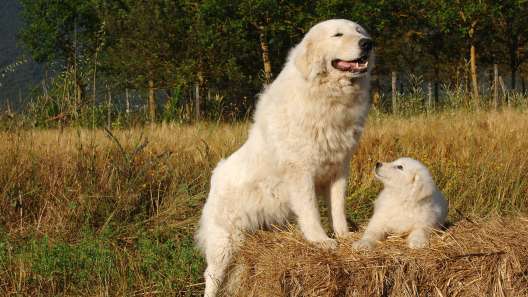-
Activity Level:
high
-
Shedding Level:
moderate
-
Grooming Level:
moderate
-
Trainability:
high
-
Good for Novice Owners:
low
-
Adaptability:
moderate
-
Kid/Pet Friendly:
often
-
Prey Drive:
moderate
-
Watchdog:
very alert
- Average Size: Large
- Average Lifespan: 11-13 years
- Registered?: aca
Maremma Sheepdog Dog Breed Information
Overview
Temperament
Adaptability
Health
Owner Experience
Grooming
Activity Level
Size
Life Span
Did You Know?
The Maremma Sheepdog, which in Italian is translated as “Cane da Pastore Maremmano-Abruzzese”, is best classified as a livestock guardian breed. One of the facts about Maremma Sheepdogs is that they have origins dating back to the Roman Empire.
These dogs originated in Italy, particularly the Tuscany, Lazio, and Southern Italy regions. Although their origins can be traced back further, the modern Maremma originated in these areas centuries ago.
They were used to guard and protect sheep from wolves. Much like the Akbash or Anatolian Shepherd, this dog breed has been known to be very accomplished at guarding the flock; doing a fine job of keeping potential predators at bay.
Although sheep farming in the Maremma marshlands has decreased substantially in the modern era, these dogs are still widely used in Abruzzo and surrounding areas; Abruzzo a nearby region where sheep herding is alive, well, and vital.
While the breed is currently not recognized by the AKC or ACA, this breed has a standard recognized by multiple kennel clubs around the world. Some of the clubs are the Ente Nazionale della Cinofilia Italiano (ENCI), the national dog association of Italy, the Australian National Kennel Council (ANKC), the UK-based Kennel Club (UKC), the Maremma Sheepdog Club of America (MSCA), and more.
The sheepdogs common to Maremma and Abruzzo used to be considered two separate breeds in Italian dog clubs; partly because the two regions were in two separate countries before the reunification of Italy in 1860. In 1958, the ENCI officially unified the recognition of these dogs into the “Maremmano-Abruzzese;” the breed we know as the Maremma Sheepdog. A typical Maremma Sheepdog will have a large, solid build and a thick, soft white coat.
These working dogs are known for having a balanced nature and serving as effective protectors of livestock. Although naturally wary and suspicious of strangers, these dogs are affectionate with their families.
Their independent working nature may mean that they aren’t necessarily “velcro dogs,” but they do bond and enjoy time with their favorite humans. They are known to be devoted to their family units. Well-socialized, they get along well with children as well as other dogs and pets that they have been raised with.
As a protective guardian breed that can be territorial, socialization and training early and often are essential for this dog breed. Although they aren’t known for barking unnecessarily, their watchdog instincts also mean they can be prone to excessive barking when there is something worth alerting for or if they are poorly trained or not well-socialized.
Socialization and training your dog to stop barking can help keep this to normal alerts. Although they can warm up to people as they are introduced and become more familiar with them, they usually aren’t the types of dogs to seek affection from people outside of their “flock.”
At the heart of the Maremma Sheepdog, they are a mountain dog. They are best suited to cooler environments due to their thick coats and can be sensitive to heat. Because of this dog breed’s size accompanied by centuries of breeding to guard flocks over large wide open spaces, the Maremma Sheepdog is not well-suited for apartment living.
These dogs are also working dogs. They need a job to do to be happy and healthy and will get bored easily. If they do not get enough exercise or mental stimulation, they will find their own job, which may not necessarily be something you want them to do. Although they are used to being independent while working, that does not mean you can leave them alone for long periods of time. These dogs do bond closely with their families and won’t appreciate being away from them for too long.
The Maremma Sheepdog is a generally healthy dog breed. As with all dog breeds, there can be potential health concerns. Potential health concerns to be aware of in Maremma Sheepdogs can include eye issues and hip dysplasia. Good breeding practices and the health of the parents make a big difference in the health of Maremma Sheepdog puppies.
Reputable breeders will screen their dogs to make sure they are not passing preventable issues to puppies. Make sure you ask the breeder about the health and genetic history of both parents. Overall knowledge, transparency about their program, willingness to answer questions, and more are all things to look for in a responsible dog breeder.
As a large, deep-chested dog breed, the Maremma Sheepdog is at a higher risk of bloat. Bloat in dogs can be dangerous and quickly becomes fatal if the stomach flips (i.e.; gastric dilation volvulus occurs). It’s important to know what you can do to reduce the risk and what symptoms mean you need to get to the emergency vet.
Maremma Sheepdogs are highly intelligent and highly trainable dogs. But, they are also independent and can be stubborn. They need consistent, clear, and firm training from a confident owner they respect and trust who builds a bond with them. A Maremma that trusts and has a bond with you is easier to please and eager to respond to consistent and clear training and expectations.
These are big challenges for first-time or inexperienced dog owners. As such, these dogs are recommended for more experienced owners. Puppy training classes or the help of a professional dog trainer with experience in training working breeds are recommended.
Maremma Sheepdogs are one of the fluffiest dog breeds and they are known for their thick white coats. They will shed a little year-round and shed heavier twice a year as the seasons change. Their thick, all-weather coat requires daily care to remove tangles and prevent mats.
A brush, a comb, a grooming glove, and a shedding blade or undercoat rake are good types of dog grooming brushes to have on hand. The occasional bath is also needed to keep this dog’s coat healthy and looking great. The Maremma coat is built for working outside, so it tends to naturally repel dirt a bit. However, if your Maremma gets into a lot of mischief on outdoor adventures, you may need to bathe them more often.
In addition to coat care, you will also need to take care of your Maremma Sheepdog’s nails, ears, and teeth. Nail trims once or twice a month are usually enough to keep nails from growing too long. Weekly ear checks and careful cleanings as needed can help prevent ear infections. Safely brushing your dog’s teeth every day, in addition to cleanings at the vet when needed, helps prevent painful dental diseases later in life.
It’s a good idea to get your dog used to grooming early and to keep the experience a positive one. Not only does this help build a bond with your dog, but it also makes grooming and maintenance tasks much easier as your Maremma Sheepdog puppy grows.
The Maremma Sheepdog is a high-energy working dog. They were bred to be with their flocks at all times, day and night. As such, they need a job to do and plenty of exercise to stay happy and healthy.
If this dog isn’t put to work on a ranch or farm protecting animals, they will need several long walks a day and time to run free. However, they do have a tendency to roam and patrol. Even though they tend to stick close to “their territory,” this does not mean that they won’t try to expand that area if permitted to do so.
Because of this, they should only be let off-leash in secure areas or areas with clear property lines for them. The exception would be when they are well-socialized and you know they won’t be aggressive towards strangers while out and about, have mastered the recall command, and you are confident they will respond to it when they are off-leash.
A fully-grown Maremma Sheepdog usually stands 24-29 inches tall and weighs 65-100 pounds.
Maremma Sheepdogs generally live for 11-13 years on average.
A Maremma was used in 2006 to protect a population of penguins in Australia. It was the world’s first trial of the kind and showed that, although a rare occurrence, a Maremma Sheepdog could help protect populations of endangered species from predators. The Middle Island Maremma Project continues today.








